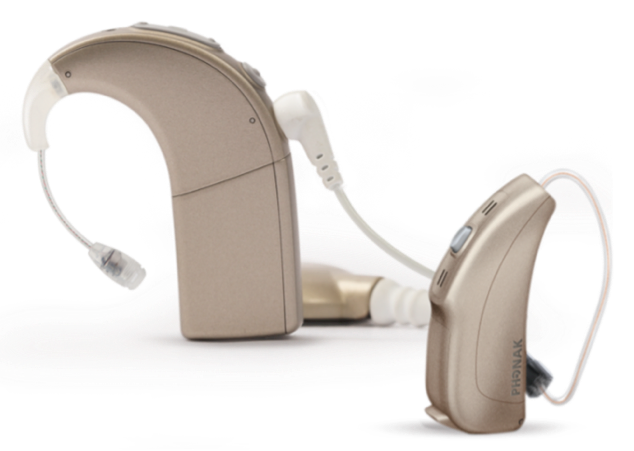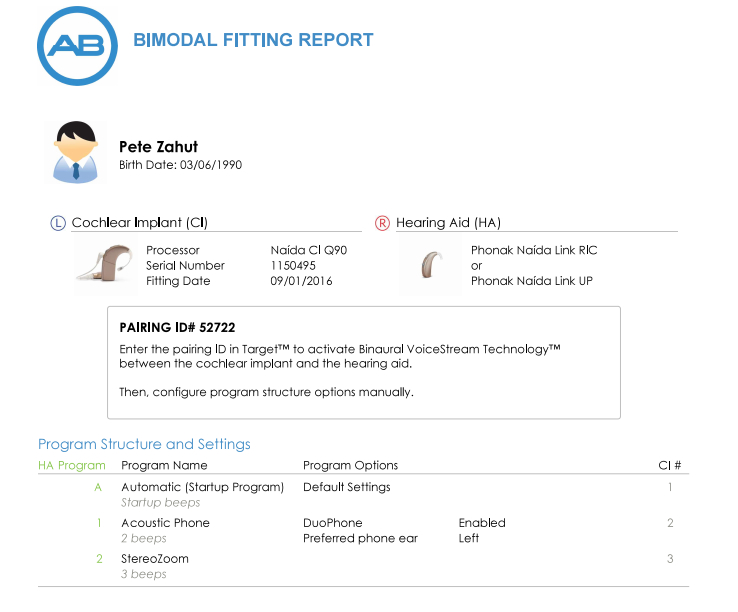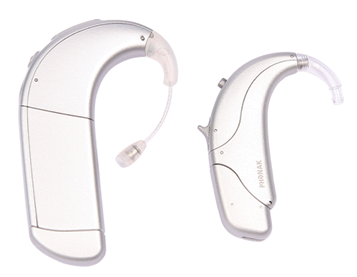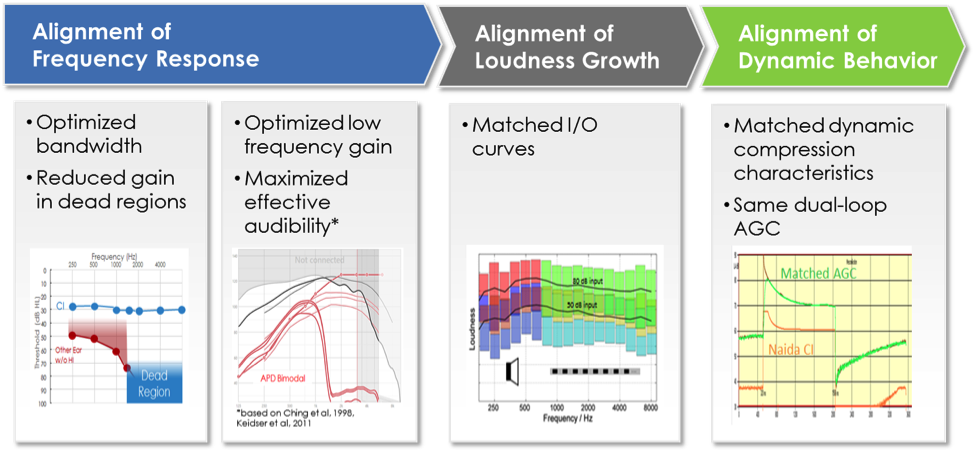This is an edited transcript of an Advanced Bionics webinar on AudiologyOnline.
Learning Outcomes
After this course, learners will be able to:
- Describe the latest innovation from Advanced Bionics.
- Describe the benefits of the latest innovation from Advanced Bionics.
- Identify the features and assistive technologies that are available with the latest innovation from Advanced Bionics.
Introduction
The latest innovation from Advanced Bionics (AB) is the Naída Bimodal Hearing Solution shown in Figure 1. Today’s discussion will cover the following topics: benefits of bimodal hearing, details about the Naída Bimodal Hearing Solution, information about the new Phonak Naída LinkTM hearing aid, and fitting of the Naída Bimodal Hearing Solution.

Figure 1. Naída Bimodal Hearing Solution.
Increasingly, more cochlear implant recipients are wearing a hearing aid in their contralateral ear. This is a big change from what recipients experienced in the past. It was not that long ago when cochlear implant recipients were told that they should remove their hearing aid from the contralateral ear after receiving a cochlear implant.
Benefits of Bimodal Hearing
There are many proven benefits of bimodal hearing. Research has shown that two ears are better than one. Numerous bimodal recipients report that bimodal hearing provides a richness and a fullness of sound quality that they do not receive with a cochlear implant alone. Additional benefits include better access to low frequency information, improved speech understanding in quiet, improved speech understanding in noise, and improved sound quality while listening to music (Potts, Skinner, Litovsky, Kuk, & Strube, 2009).
AB and Phonak worked together to take bimodal hearing to the next level. The Naída Bimodal Hearing Solution offers a new way to deliver the bimodal hearing experience by providing two devices that work together to optimize hearing. This new, unique solution from AB includes Phonak's Naída Link hearing aid and AB's Naída CI (Q70 or Q90) sound processor. These two devices are designed to work together to make bimodal hearing easy.
What makes the Naída Bimodal Hearing Solution unique from other bimodal options that recipients are already using? Naída CI and Naída Link were created to work together to optimize bimodal hearing. The Naída Bimodal Hearing Solution makes it easy to hear.
Traditionally, hearing aids and cochlear implants have utilized very different signal processing. A recent study concluded that bimodal recipients preferred the sound quality of matched devices and demonstrated improved speech understanding (Veugen, Chalupper, Snik, Opstal, & Mens, 2016). The Naída Bimodal Hearing Solution provides the best way to combine a cochlear implant and a hearing aid by providing shared signal processing between the two devices.
The Naída Bimodal Hearing Solution is easy to use because many of Phonak’s front-end processing features are available on both Naída CI and Naída Link as shown in Figure 2. UltraZoom and auto UltraZoom are designed to improve speech understanding in noise. SoundRelax and WindBlock are designed to work together to improve comfort. QuickSync improves ease of use by allowing the bimodal recipient to change programs and/or volume on both the hearing aid and the cochlear implant with just one quick touch.
The Naída Bimodal Hearing Solution makes it easy for recipients to communicate by allowing them to hear important sounds in both ears. With Binaural VoiceStream Technology™ features like DuoPhone, ZoomControl, and StereoZoom (Figure 2), the desired signal is streamed between the Naída CI and the Naída Link hearing aid, ensuring that important information is heard in both ears. When recipients are in difficult listening situations (e.g., talking on the phone, in the car, or at a social gathering), they can benefit from the advanced technologies like DuoPhone, ZoomControl, and StereoZoom because Naída CI and Naída Link were designed to work together.

Figure 2. Phonak technologies available with the Naída Bimodal Hearing Solution.
The Naída Bimodal Hearing Solution makes it easy for recipients to connect to the world around them. Numerous Phonak accessories are available for use with the Naída Bimodal Hearing Solution including Roger™ receivers, ComPilot, RemoteMic, TVLink, DECT Phone and EasyCall. Research has shown the benefit of these types of accessories for both cochlear implant and hearing aid recipients.
Clinical Fitting Benefits
The benefits that have been addressed thus far have been focused on recipients and how the Naída Bimodal Hearing Solution improves the bimodal hearing experience for them. What about the professionals fitting these devices? How does the Naída Bimodal Hearing Solution impact clinical management of a bimodal recipient?
The Naída Bimodal Hearing Solution is easy to program with simple, effective fittings for both devices. Two features that make programming easy are the bimodal fitting report (Figure 3) and a unique bimodal fitting formula. The bimodal fitting report is generated in the SoundWave™ fitting software. This report will guide the hearing aid clinician in programming the hearing aid for use with the cochlear implant. The unique bimodal fitting formula is the Adaptive Phonak Digital (APD) Bimodal fitting formula. The APD Bimodal fitting formula was developed in collaboration between AB and Phonak. The goal of the APD Bimodal fitting formula is to align the acoustic signal from the hearing aid toward the electric stimulation provided by the cochlear implant. The Naída Link is fit using Phonak’s Target fitting software, and the Naída CI is fit using AB’s SoundWave fitting software. It is likely that many hearing healthcare professionals are already familiar with one or both of these software platforms.

Figure 3. Bimodal Fitting Report (Page 1). Click here for a larger version of this report.
Phonak Naída LinkTM Hearing Aid
Let's take a closer look at the Naída Link hearing aid. There are two options available for Phonak Naída Link: the Naída Link Ultra Power (UP) and the Naída Link Receiver-in-the-Canal (RIC). The fitting range of each hearing aid is shown in Figure 4. The Naída Link UP will fit up to a profound hearing loss. The Naída Link RIC fitting range is from mild to severe. With these two hearing aids, the Naída Bimodal Hearing Solution has a hearing aid option for every bimodal recipient. The entire range of hearing loss is covered.

Figure 4. Naída Link fitting ranges.
The Naída Link hearing aid is a unique Phonak hearing aid that is compatible with AB sound processors and will be distributed by AB in the US. Naída Link is available in seven colors that match Naída CI colors: Alpine White, Silver Gray, Sand Beige, Chestnut, Velvet Black, Petrol, and Ruby Red.
Recipients programmed in SoundWave 3.0 are able to utilize Naída Link paired with Naída CI. Pairing these two devices allows Naída CI and Naída Link to communicate with each other, providing access to Binaural VoiceStream Technology features with both Naída CI and Naída Link. As a reminder, Binaural VoiceStream Technology features include DuoPhone, ZoomControl, StereoZoom, and QuickSync. For professionals who are already programming bilateral Naída CIs, many of these features will be familiar already. Binaural VoiceStream Technology features are designed to improve speech understanding in noise and improve ease of use for the recipient.
Another benefit of the Naída Bimodal Hearing Solution is that recipients are able to use the ComPilot as a remote control for both devices when Naída CI is programmed in SoundWave 3.0.
Naída Link and Naída CI were designed to work together with matched signal processing and have numerous features that are aligned between the two devices (Figure 5). Both devices process sound in the same way, making it easy to hear. There are also many automated features available with both devices making the Naída Bimodal Hearing Solution easy to use.

Figure 5. Naída CI and Naída Link: Made for each other.
The advanced technologies in the Naída Bimodal Hearing Solution include features that provide improved speech understanding in noise, improved comfort, and improved ease of use for the recipient. This aligned signal processing and feature compatibility is available with the Naída Bimodal Hearing Solution because Naída Link and Naída CI were designed to work together.
Wireless Accessories
The Naída Bimodal Hearing Solution is compatible with many Phonak wireless accessories including Phonak's multi-purpose solutions (Roger, ComPilot, Remote Mic, and TVLink) and Phonak's dedicated phone solutions (EasyCall and DECT Phone) as shown in Figure 6.

Figure 6. Wireless accessories for the Naída Bimodal Hearing Solution.
Multipurpose Solutions. Integrated Roger receivers are now available for Naída CI and Phonak Naída Link as shown in Figure 7. The Roger 17 integrated receiver is compatible with Naída CI. Roger 10 is for use with Naída Link UP, and Roger 15 is for use with Naída Link RIC. Roger can provide benefit in noise and over distance for recipients with the Naída Bimodal Hearing Solution (Wolfe, Morais, Schafer, Mills, Mülder, Goldbeck, Marquis, John, Hudson, Peters, & Lianos, 2013). Roger's adaptive behavior and beamformers have repeatedly proven superior speech understanding in noise for cochlear implant and hearing aid recipients. Another benefit of Roger is that it is hassle-free. There are no frequencies to program and manage, and the devices are connected with one single click. For additional information on Roger and the Naída Bimodal Hearing Solution, refer to Resource 1: Naída Bimodal Hearing Solution and Roger.

Figure 7. Naída CI and Naída Link with Roger receivers.
ComPilot is another great option for recipients with the Naída Bimodal Hearing Solution. ComPilot can be used to stream audio to both Naída CI and Naída Link. Recipients with the Naída Bimodal Hearing Solution also can use ComPilot as a remote control to change programs and/or volume on both their hearing aid and their cochlear implant.
Dedicated Phone Solutions. Phonak's dedicated solutions, DECT Phone and EasyCall, are also compatible with the Naída Bimodal Hearing Solution. DECT Phone can stream important phone calls from landline phones directly to Naída CI and Naída Link. EasyCall can stream phone calls from any Bluetooth cell phone directly to Naída CI and Naída Link.
Adaptive Phonak Digital (APD) Bimodal Fitting Formula
The APD Bimodal fitting formula is exclusively available for use with Phonak Naída Link. This uniquely designed fitting formula aligns Naída Link signal processing with Naída CI's signal processing.
AB and Phonak worked very closely over a several to develop this fitting formula that is designed to optimize hearing for recipients with the Naída Bimodal Hearing Solution. Bimodal recipients are a very diverse group of individuals; consequently, a series of studies was conducted to determine which hearing aid program modifications should be applied by this fitting formula, based upon the recipient's hearing loss and hearing aid configuration. The formula has been evaluated at five sites: Advanced Bionics (Valencia, California), The Ear Group (Antwerp, Belgium), Radboud University (Nijmegen, Netherlands), Medizinische Hochschule Hanover (Hanover, Germany), and Washington University (St. Louis, Missouri).
Why Not Use Traditional Fitting Formulas for Bimodal Fittings?
Why is a uniquely designed fitting formula needed for bimodal recipients? Traditional hearing aid formulas (e.g., NAL-NL2, DSL v5) are not designed to align the acoustic and the electric signal processing, which is required for optimal bimodal hearing. For example, traditional fitting formulas focus amplification in frequency regions that are important for speech understanding, in the range between 1000 and 4000 Hz. However, research has shown that low frequency information (in the range of 250 Hz to 750 Hz) may be the most important to maximize bimodal benefit. Low compression thresholds and moderate compression ratios are usually prescribed in hearing aids while cochlear implants use very different input/output functions. Finally, the dynamic behavior of the automatic gain control (AGC) for a hearing aid and a cochlear implant differ substantially. Hearing aids typically implement syllabic compression, and cochlear implants use slow-acting AGC.
Using a traditional fitting formula with a bimodal recipient may result in a misaligned frequency response by providing inappropriate gain across the frequency range of the hearing aid. Again, traditional fitting formulas often do not provide enough low frequency gain, and may provide too much gain in frequencies where the recipient may not receive benefit because of their degree of hearing loss. Another reason that using a traditional fitting formula with a bimodal recipient may also result in misaligned loudness growth is because the two devices have very different compression thresholds and compression ratios. Hearing aid compression thresholds are typically lower than those in a cochlear implant. Finally, using a traditional fitting formula with the bimodal recipient may also result in misaligned AGC function, as the attack and release times in a hearing aid are much faster than in a cochlear implant.
The goal of the APD Bimodal fitting formula is to align the acoustic signal toward the electric stimulation. The APD Bimodal fitting formula first became available for fitting Naída Link in Target 4.3. In Target, when a Naída Link is connected, the APD Bimodal fitting formula is available in the same location where the traditional fitting formulas are found.
The APD Bimodal fitting formula is designed to provide an optimized fitting with just one click. The APD Bimodal fitting formula provides automatic calculations to align the frequency response, align the loudness growth and align the dynamic behavior of the two devices as shown in Figure 8.

Figure 8. APD Bimodal fitting formula’s automatic calculations.
Frequency Response. With the APD Bimodal fitting formula, the frequency response is aligned by optimizing low frequency gain and bandwidth. Low frequency gain optimization uses the model of effective audibility to ensure that cues that contribute to speech understanding, even in relatively quiet environments, are audible to the recipient. Depending on the configuration of the audiogram, this low frequency gain optimization often results in a gain increase below 1000 Hz. With the APD Bimodal fitting formula, bandwidth is optimized by ensuring that the bandwidth is as wide as possible, frequencies between 250 and 750 Hz are audible, and amplification is not applied in cochlear dead regions.
Loudness Growth. With the APD Bimodal fitting formula, loudness growth is aligned by matching the input/output function of the cochlear implant and the hearing aid. Essentially, the compression threshold and the compression ratio for the Naída Link is the same as what is utilized with Naída CI.
Dynamic Behavior. The APD Bimodal fitting formula aligns dynamic compression behavior by utilizing the Naída CI dual-loop AGC in the hearing aid.
All three of these modifications were verified and optimized in the previously referenced evaluations and included many bimodal listeners from all over the world.
For additional information on the APD Bimodal fitting formula, refer to Resource 2: APD Bimodal Fitting Formula White Paper.
When comparing the APD Bimodal fitting formula with Phonak’s Adaptive Phonak Digital fitting formula, there is almost no difference in the frequency response for a flat hearing loss. However, for a sloping hearing loss with a dead region identified, amplification is not provided in the dead region with the APD Bimodal fitting formula as shown in Figure 9.

| |
Figure 9. Comparison of the Adaptive Phonak Digital and the APD Bimodal fitting formulas with a sloping hearing loss. Figures show prescribed output for speech of 50, 65, and 80 dB SPL for a sloping hearing loss.
This APD Bimodal fitting formula is available in a Phonak Target software, so that the Naída Link can be programmed using simple, easy to execute steps. In most cases, optimum bandwidth and balance loudness are achieved immediately when the APD Bimodal fitting formula is selected.
A recent study published in Ear and Hearing (Veugen et al., 2016) demonstrated the benefit of aligning the signal processing between the two devices. Results from this study showed that an aligned AGC improves speech understanding in noise by up to 2 dB over the standard Phonak AGC.
Verification. For professionals who perform real-ear verification for hearing aid recipients, AB has guidelines to assist with performing verification with the APD Bimodal fitting formula. This process differs slightly from a traditional fitting formula as there are no “targets” for APD Bimodal fitting formula in real-ear verification equipment.
There are two methods that can be used for verification with the Naída Link in the absence of fitting formula targets. These methods are not specific to the Naída Link; these methods can be used whenever performing real-ear verification without a fitting formula target.
The two methods are:
- Expected versus measured output or gain (for any level of hearing loss)
- Compare prescribed hearing aid output/gain curves from Target to the hearing aid
- Or, compare predicted versus measured output/gain at specific frequencies
- Assess audibility with the Speech Intelligibility Index (for mild-moderate flat hearing loss)
- Moderate speech (65 dB) LTASS should generally be above threshold with an Speech Intelligibility Index of approximately 70
For additional information on performing verification with the APD Bimodal fitting formula, refer to Resource 3: APD Bimodal Fitting Formula Verification.
Easy to Program
Another benefit of the Naída Bimodal Hearing Solution is that it is easy to program. The Naída Bimodal Hearing Solution provides simple effective fittings of both devices. The steps are quite simple in general, especially for professionals who already have experience with SoundWave and Target.
Full bimodal capabilities are available when Naída CI is fit in SoundWave 3.0 or newer. Naída Link will be fit in Phonak Target version 4.3 or newer.
Fitting the Naída bimodal hearing solution is easy, requiring only a couple of simple steps to fit.
- Initialize Naída CI (Q70 or Q90) as a bimodal sound processor and program in SoundWave
- Program Naída Link in Target using the Bimodal Fitting Report generated in SoundWave
Fitting the Naída bimodal hearing solution is easy and efficient!
For additional details on fitting the Naída Bimodal Hearing Solution in SoundWave and in Target, refer to Resource 4: Fitting the Naída Bimodal Hearing Solution.
Recipients with the Naída Bimodal Hearing Solutions will benefit from utilizing Binaural VoiceStream Technology features including DuoPhone, ZoomControl, StereoZoom, and QuickSync. Recipients with the Naída Bimodal Hearing Solution also can benefit from using ComPilot as a remote control for Naída CI and Naída Link.
Many of these advanced technologies were designed to improve speech understanding in difficult listening situations, like talking on the phone or communicating in noise. QuickSync was designed to improve ease of use by allowing a recipient to change the volume and/or the program on both devices at the same time.
Recipients with the Naída Bimodal Hearing Solution have aligned signal processing when the APD Bimodal fitting formula is used with Naída Link.
Recipients with the Naída Bimodal Hearing Solution can benefit from many of the wireless accessories from Phonak, including Roger Pen, Roger Clip-On Mic, ComPilot, RemoteMic, TVLink, EasyCall, and DECT Phone. These wireless solutions make it easy for recipients to engage with the world around them. Recipients with the Naída Bimodal Hearing Solution can use integrated Roger receivers with both devices for improved speech understanding in noise and over distance. ComPilot can stream audio to both the hearing aid and the cochlear implant. DECT Phone and EasyCall to stream important phone calls to both devices as well.
Resources
Information about the Naída Bimodal Hearing Solution is available on AB's website. If there are candidates or recipients who want to know more about AB's new bimodal hearing solution, they can find the information on the AB website in the Products section.
Professionals can view virtual trainings on the Naída Bimodal Hearing Solution on the AB website in the Professionals section.
There are several additional resources available from AB. These include an updated Candidate Counseling Kit as well as several brochures, including a new Candidate brochure. The Naída Link User Guide is available on Phonak's website.
Tools for Schools (TFS)
TFS provides helpful information for educating teachers and other students in the classroom about hearing loss and cochlear implant use. TFS provides resources that support bimodal hearing and include Bimodal Hearing Basics (Resource 5) and the Bimodal Technology Summary sheet (Resource 6). Visit the TFS Program at AdvancedBionics.com/tfs to download free resources to support children with cochlear implants in the classroom.
Summary
AB is excited about the Naída Bimodal Hearing Solution and is pleased to offer Naída Link as a new system kit option in North America and some European countries.
Naída CI and Naída Link were made for each other. The Naída Bimodal Hearing Solution makes it easy to hear with aligned signal processing via the APD Bimodal fitting formula. The Naída Bimodal Hearing Solution provides features that improve speech understanding in noise, improve comfort, and improve ease of use for AB recipients.
The Naída Bimodal Hearing Solution makes it easy to connect with compatible Phonak accessories. The Naída Bimodal Hearing Solution makes it easy for AB recipients to communicate by ensuring that the recipient hears the important sounds in both ears with features like DuoPhone, ZoomControl, and StereoZoom. Finally, the Naída Bimodal Hearing Solution makes it easy to program by offering simple, effective fittings of both devices which provides a great advantage for those of who are working in the clinic with bimodal AB recipients.
Questions and Answers
What version of SoundWave is needed to program Naída CI for use with Naída Link?
SoundWave 3.0 (and newer versions) will allow initialization of Naída CI (Q70 or Q90) for bimodal use. This bimodal initialization provides the Pairing ID which unlocks additional bimodal features in Target.
Can the APD Bimodal fitting formula be used with any Phonak hearing aid?
No. The APD Bimodal fitting formula is exclusively available for the Phonak Naída Link hearing aid.
Can I use other fitting formulas with Naída Link? Yes. Traditional hearing aid formulas are available in Target for use with Naída Link. However, based on all of the reasons that were just covered, it is recommended that recipients with Naída Link use the APD bimodal fitting formula.
Will Naída Link come with a loss and damage warranty?
Yes. The standard international warranty on all Phonak hearing aids is one year. That will be the warranty that will come with the Naída Link. Extended warranty options are available from AB as well.
When using the ComPilot as a remote, are you able to change each device individually or is it simultaneous program and/or volume changes?
When using ComPilot as a remote, pushing the button to change either volume or program will make a change to both devices simultaneously.
Can I contact AB customer service and order now?
Yes. Naída Link is available for AB recipients now.
References
Potts L., Skinner M., Litovsky R.Y., Kuk F., & Strube M. (2009). Recognition and Localization of Speech by Adult Cochlear Implant Recipients Wearing a Digital Hearing Aid in the Non-implanted Ear (Bimodal Hearing). International Journal of Audiology, 20, 353-373.
Veugen, L.C., Chalupper, J., Snik, A.F., Opstal, A.J., & Mens, L.H. (2016). Matching automatic gain control across devices in bimodal cochlear implant users. Ear & Hearing, 37(3), 260-70. doi: 10.1097/AUD.0000000000000260
Wolfe, J., Morais M., Schafer E., Mills, E., Mülder, H. E., Goldbeck, F.,...Lianos, L. (2013). Evaluation of speech recognition of cochlear implant recipients using a personal digital adaptive radio frequency system. Journal of the American Academy of Audiology, 24(8), 714-724.
Citation
Hambrick, L. (2017, January). Introduction to AB's latest innovation: The Naída Bimodal Hearing Solution. AudiologyOnline, Article 19063. Retrieved from https://www.audiologyonline.com.
